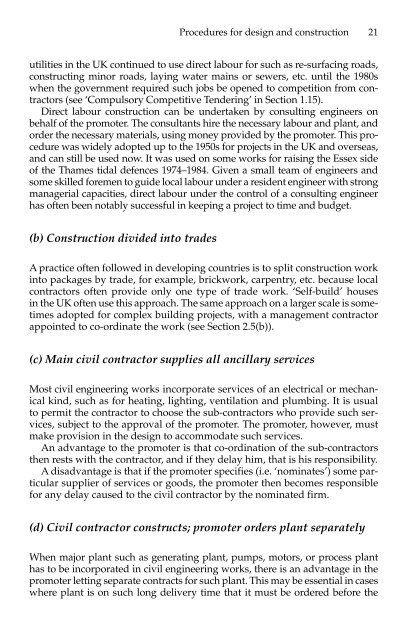Civil Engineering Project Management (4th Edition)
Create successful ePaper yourself
Turn your PDF publications into a flip-book with our unique Google optimized e-Paper software.
utilities in the UK continued to use direct labour for such as re-surfacing roads,<br />
constructing minor roads, laying water mains or sewers, etc. until the 1980s<br />
when the government required such jobs be opened to competition from contractors<br />
(see ‘Compulsory Competitive Tendering’ in Section 1.15).<br />
Direct labour construction can be undertaken by consulting engineers on<br />
behalf of the promoter. The consultants hire the necessary labour and plant, and<br />
order the necessary materials, using money provided by the promoter. This procedure<br />
was widely adopted up to the 1950s for projects in the UK and overseas,<br />
and can still be used now. It was used on some works for raising the Essex side<br />
of the Thames tidal defences 1974–1984. Given a small team of engineers and<br />
some skilled foremen to guide local labour under a resident engineer with strong<br />
managerial capacities, direct labour under the control of a consulting engineer<br />
has often been notably successful in keeping a project to time and budget.<br />
(b) Construction divided into trades<br />
Procedures for design and construction 21<br />
A practice often followed in developing countries is to split construction work<br />
into packages by trade, for example, brickwork, carpentry, etc. because local<br />
contractors often provide only one type of trade work. ‘Self-build’ houses<br />
in the UK often use this approach. The same approach on a larger scale is sometimes<br />
adopted for complex building projects, with a management contractor<br />
appointed to co-ordinate the work (see Section 2.5(b)).<br />
(c) Main civil contractor supplies all ancillary services<br />
Most civil engineering works incorporate services of an electrical or mechanical<br />
kind, such as for heating, lighting, ventilation and plumbing. It is usual<br />
to permit the contractor to choose the sub-contractors who provide such services,<br />
subject to the approval of the promoter. The promoter, however, must<br />
make provision in the design to accommodate such services.<br />
An advantage to the promoter is that co-ordination of the sub-contractors<br />
then rests with the contractor, and if they delay him, that is his responsibility.<br />
A disadvantage is that if the promoter specifies (i.e. ‘nominates’) some particular<br />
supplier of services or goods, the promoter then becomes responsible<br />
for any delay caused to the civil contractor by the nominated firm.<br />
(d) <strong>Civil</strong> contractor constructs; promoter orders plant separately<br />
When major plant such as generating plant, pumps, motors, or process plant<br />
has to be incorporated in civil engineering works, there is an advantage in the<br />
promoter letting separate contracts for such plant. This may be essential in cases<br />
where plant is on such long delivery time that it must be ordered before the


















